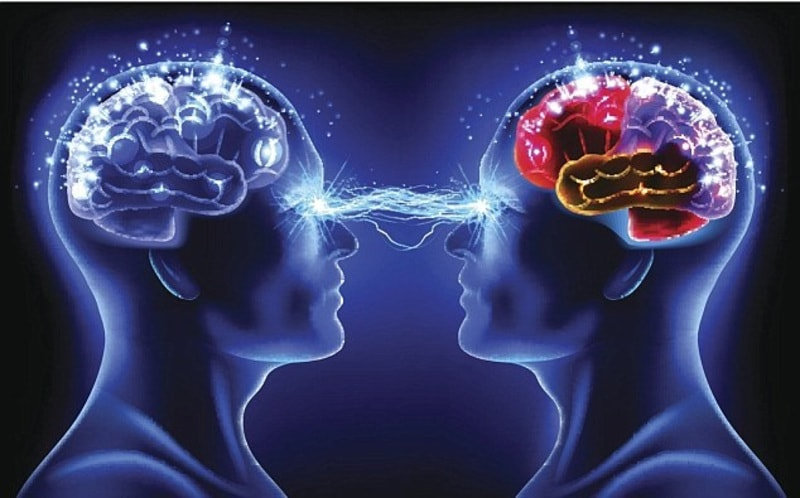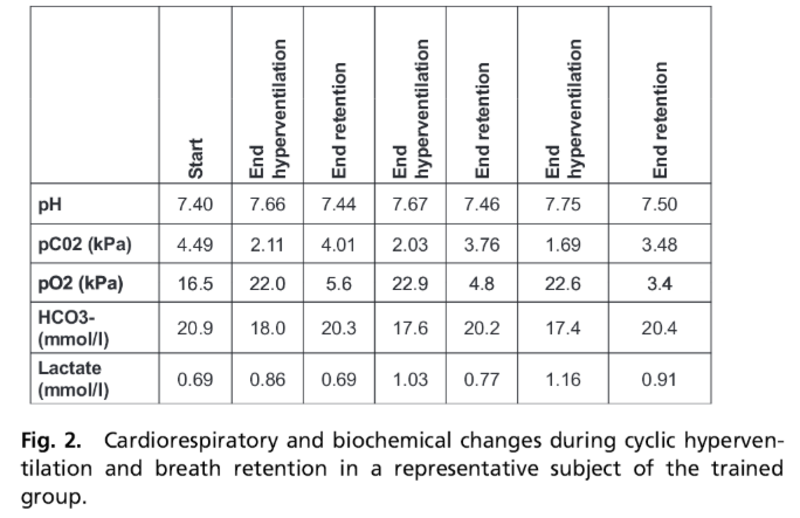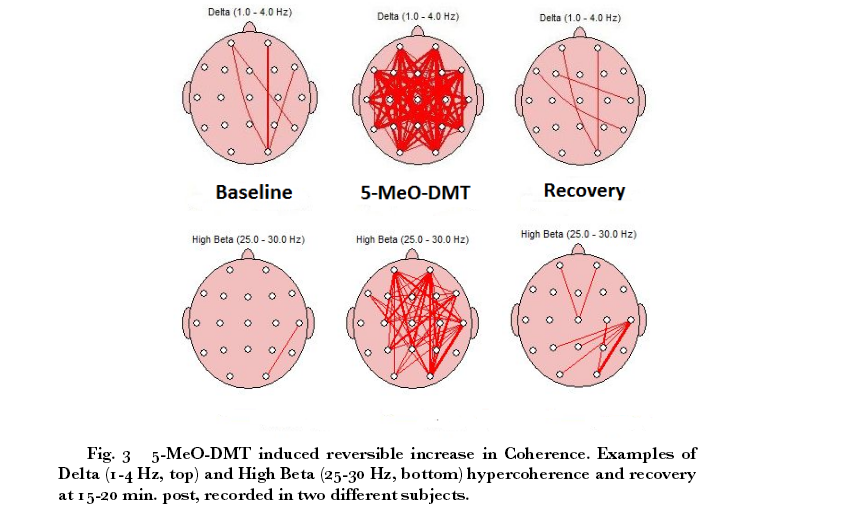So far we’ve covered quite an array of topics that seem to coincide with Gamma Waves and potentially endogenous DMT synthesis.
We have “Aha!” moments, lucid dreaming, sleep paralysis, electrically induced lucid dreaming, “Out of Body Experiences”, REM Sleep, meditation, deep hypnosis (& subsequent anomalistic effects), “Past Life Recollection”, hypnagogia, “Near Death Experiences”, Deja Vu, “Psychic Mediumship”, & “The God Helmet” experiences. We’ve also included the EEG findings from Ayahuasca administration as well as DMT ingestion.
Let’s continue down the bunny hole of analyzation of commonalities amongst the “supernormal”… “paranormal”… or whatever you’d like to label it as.
Like we stated in Part 3, the creator of the original EEG machine was a man named Hanz Berger. He developed the device in order to quantify what he believed to be the ability of humans to communicate “telepathically”. He failed to succeed but as stated previously, we believe that it might coincide with the inability of analog EEG devices to measure brain waves above 25 Hz (Gamma).
The controversial potential of “telepathic” communication is the fact that it might change what mainstream science “knows” about the origin of consciousness. The subject also causes us to ask deeper questions about what we understand about outside electromagnetic influences on the brain and behavior. About 8 months ago DMT Quest attempted to project the biological parameters for optimal conditions for successful “telepathic” transfer.A 2008 study in the International Journal of Yoga outlined the brain imaging of a man named Gerard Senehi during “Telepathic” transfer between himself and another subject. The results was as follows: “The mentalist demonstrated significant activation of the right parahippocampal gyrus after successful performance of a telepathic task. The comparison subject, who did not show any telepathic ability, demonstrated significant activation of the left inferior frontal gyrus.”
Another study in 2012 in the International Journal of Yoga would verify whether a different person, a man named Sean Harribance would showcase the same neural correlates with “psychic” ability compared to the 2008 study. The results were as follows:
“The raw data from the unique electroencephalographic pattern displayed by Sean Harribance during his intuitive state revealed a peak increase of power within the upper beta range (20-30 Hz) within the right parahippocampal region only. The congruence of the region of activation during “telepathy” by Sean Harribance and Gerard Senehi, especially when the specific electromagnetic and cellular characteristics are considered, suggests the parahippocampal region may be a focus for exploration of the mechanisms by which these phenomena might occur.”

This would appear to be rather intriguing results based on two findings.
The first one is that the right parahippocampal gyrus area was activated during successful “telepathy” in Mr. Senehi as well as “psychic mediumship” in Mr. Harribance.
The second one is that the 2012 study showcased Mr. Harribance as having showcased an “upper beta” range during his psychic performance. Being that we’ve outlined the initial limitations of analog EEG machines (limited to less than 25 Hz) compared to digital EEG machines (Part 1), as well as the propensity for different researchers to label waves between 25 and 35 Hz (interchanging Beta for Gamma & vice versa) based on personal preference, we believe that “upper beta” can easily be interchanged for “gamma” or “lower gamma”. Many researchers will label 25 Hz and above as simply “Gamma”. (We’ve seen this in the earlier study regarding electrically induced “lucid dreaming” as well as studies published in the Public Library of Science, Frontiers in Human Neuroscience, Conference Proceedings of the IEEE Engineering in Medicine and Biology Society, Cognitive Processing, Frontiers in Human Neuroscience, Frontiers in Integrative Neuroscience, and Neuron.)
There appears to be a lack of consistency in the labeling of the 25 to 35Hz range among EEG researchers.
In fact, when looking at the most recent categories added to the spectrum of EEG analysis, it appears as though numerous labels have been added to the original 4 (Delta, Theta, Alpha, Beta):
“Infra-slow Oscillations”, (Less than 0.1 Hz)
“Epsilon Waves” (Less than 0.5 Hz)
“Mu wave” (9 to 11 Hz)
“SMR Wave” (13 to 15 Hz)
“Beta 1” (12 to 15 Hz)
“Beta 2” (15 to 20 Hz)
“Beta 3” (20 Hz to 26 Hz)
“Hi-Beta” (26-32 Hz)
Hyper-Gamma (Greater than 100 Hz)
Lambda Waves (Greater than 200 Hz)
To add to the amusement of our society’s incessant need to label and compartmentalize everything, the consistencies amongst the HZ range for many of these “sub-labels” seem to… once again vary according to personal preference of the researcher.
Digression is rearing itself once again… let us continue.
While some of the concepts presented in the earlier parts of this series seem rather straight forward and palatable (“Aha!” moments, REM Sleep/Lucid Dreaming, meditation), some of the latter concepts such as “psychic mediumship”, growth stimulation from hypnosis, “past life recollection”, and “telepathy” would make the average skeptic squeal with contempt. I don’t blame them as much of what we are discussing isn’t exactly embraced by mainstream scientific circles. Much of the cited studies/concepts leads us to develop questions past our own biology/physiology and beliefs as to what humans are and are not capable of.
While much of the focus of this discussion has been in regards to the EEG state during many of these “supernormal” moments, there appears to be a likelihood of correlation (direct or indirect) as it pertains to the general respiration rate of the subjects. It’s generally well-known that much of the focus of many meditative practices has to do with a variation of rhythmic, breathing exercises. We’ve also outlined the biological parameters and benefits of sleep, breath rate, and the dream state in the piece titled “Psychedelic Melatonin“). A 2010 study in the journal Advances in Experimental Medicine and Biology quantifiably documents the increased breath rate during REM sleep.
In 1991, the journal Electroencephalography and Clinical Neurophysiology published a study in regards to EEG measurements of induced hyperventilation aka respiratory alkalosis. The conclusion was as follows: “Hyperventilation caused an exponential increase in slow activity and a decrease in alpha power. Blood flow velocity was decreased by hyperventilation but increased by hypoxia. It is concluded that the EEG changes observed during hyperventilation must mainly or totally be attributed to factors other than cerebral hypoxia.”
In 1992, the journal Electroencephalography and Clinical Neurophysiology published a study comparing the effects of Indomethacin vs. hyperventilation-induced reduction in cerebral blood flow with EEG analysis. The study concluded: “In the hyperventilation group the blood flow velocity decreased to 63% of the initial value and the qEEG showed a marked increase in delta and theta activity, but a non-significant change in alpha peak frequency. Indomethacin and hyperventilation caused similar degrees of vasoconstriction; however, the increase in qEEG slow wave activity, which was observed only in the hyperventilation group, is apparently related to metabolic rather than haemodynamic factors.”
(The significance of these two EEG studies in regards to hyperventilation (respiratory alkalosis) is the fact that slow wave (Theta/Delta) activity increased as a byproduct. When you combine this with the observation of slow wave modulating fast wave (Gamma) activity (examples: 1, it leads us to believe that there is an apparent feedback loop between breath rate and EEG state.)
While the term “hyperventilation” generally seems to have negative connotations, deep rhythmic breathing such as that observed during REM sleep and meditation can appear to offer undeniable positive physiological benefits for both the brain and body.
One practitioner who is utilizing deep, rhythmic breathing in an undeniably “supernormal” manner is 26 Guinness World Record Holder, Wim “The Iceman” Hof. He has shown extraordinary abilities when it comes to withstanding extreme cold climates. According to the “Iceman”, he utilizes the power of his mind via meditation and breathing techniques in order to “control his internal thermostat”. In 2009, Wim would climb Mount Kilimanjaro in Tanzania (19,340 feet above sea level) in just two days. In 2009, Wim would also complete a 26 mile marathon above the arctic circle in Finland, (temperatures averaging −4 °F) while dressed in nothing but shorts. He completed the marathon in 5 hours and 25 minutes.
Not to be limited to cold challenges, in 2011 the “Iceman” would complete a 26 mile marathon in the Namibian Desert (104 °F) without drinking any water. While this would be considered very dangerous for most people due to the likelihood of one’s core body temperature overheating leading to hyperthermia and septic shock, Wim’s core temperature would remain the same throughout the marathon.

In 2014, the Proceedings of the National Academy of Sciences published a paper on the effects of the “Wim Hof Method”. The study itself comprised of 24 volunteers in which 12 of them would train for 10 days utilizing Wim’s techniques such as “Third Eye Meditation”, cold immersion, and cyclic hyperventilation followed by breath retention. The other 12 volunteers would not undergo any training at all. The study was based on observing the physiological differences in both groups after having been administered the endotoxin known as E. Coli. The results were as follows:
“Hitherto, both the Autonomic Nervous System and Innate Immune System were regarded as systems that cannot be voluntarily influenced. The present study demonstrates that, through practicing techniques learned in a short-term training program, the sympathetic nervous system and immune system can indeed be voluntarily influenced.”
“Finally, flu-like symptoms were lower in the intervention group. In conclusion, we demonstrate that voluntary activation of the sympathetic nervous system results in epinephrine release and subsequent suppression of the innate immune response in human in vivo. These results could have important implications for the treatment of conditions associated with with excessive or persistent inflammation, such as autoimmune diseases.”
Being that hyperventilation leads to respiratory alkalosis which coincides with suppressed carbon dioxide (CO2) levels which is labeled Hypocapnia (neurotic labeling rears its head once again), it brings us back to the Melatonin and DMT relationship. We’ve gone over this extensively in the pieces “DMT, Melatonin, & Miracles” & “Psychedelic Melatonin”.
(General consensus across mainstream medical circles is that both the arterial blood pH and venous blood pH are supposed to remain within a tight bandwidth between 7.35 to 7.45. Any shift or change in blood pH out of these “acceptable” parameters is considered abnormal and even dangerous. However, it’s interesting to note that in looking at the chart down below, the arterial blood pH of the Wim Hof trained group would rise as high as 7.75.)

This indicates that the Wim Hof trained practitioners are releasing significant levels of carbon dioxide (CO2) from their body during their feats. Although there have yet to be any scientific studies whether Wim is synthesizing DMT endogenously via his methodologies of breathing and meditation, the anecdotal reports from practitioners of the “Wim Hof Method” appear to be rather convincing that at a minimum there are likely trace amounts of DMT being produced from these exercises. (Of course we are making this hypothesis based on all the data presented in previous parts 1 through 5.)
In 2013, an article in the Journal of Neural Transmission postulates the following as it pertains to DMT and respiration/lungs: “Based on the available evidence, we speculate that DMT functions in the following manner. In response to a life threatening situation or the physical signals of agony, the lungs can synthesize large amounts of DMT (by quick removal of the endogenous dialyzable INMT inhibitors without the need of new enzyme synthesis) and release it into the arterial blood within seconds. Once DMT enters blood circulation, it is relatively safe from degradation since extracellular, circulating monoamine oxidase enzyme deaminate only primary amines (McEwen and Sober 1967). Therefore, the tertiary DMT is not a substrate for plasma monoamine oxidase and can reach the brain with minimal degradation.”(These are just 7 anecdotal reports from practitioners on the WHM group on Facebook (The names and pictures have been omitted to respect their privacy). We must remain cognizant that much like in Dr. Rick Strassman’s trial chronicled in his book DMT: The Spirit Molecule, different levels of DMT lead to different experiences. The lowest dose led to a euphoric feeling with no hallucinogenic properties while the highest dose led to transcendental experiences.)

While DMT is traditionally considered to be a “hallucinogenic” compound, if it is produced during the “Iceman’s” feats as well as those of his practitioners, it could lead to the recategorization of the compound altogether. Seeing something that is “not there” is one thing… being able to perform significantly measurable, “abnormal” & “supernormal” feats during the synthesis of a compound is something else altogether. Perhaps this is one of the ways “nature” intended DMT to be accessed?

(The above image was provided from a study on exogenous DMT administration published in The Journal of Natural and Social Philosophy in 2015. The same coherence was observed across Gamma bands as well. DMT appears to signify a “Lucy” type of effect on brain coherence.)
In 2012, the journal Psychosomatic Medicine published a study on Wim Hof’s physiological measurements from being fully immersed in ice for 80 minutes as well as his biological reaction to endotoxemia administration.
DMT Quest reached out to the scientists who conducted this study and received additional information from a document titled “Supplementary Digital Content”. The information we were looking for was specifically as it pertained to the EEG data of Wim Hof. It is as follows:
“The EEG showed normal cortical background activity at baseline, with an occipitoparietotemporal alpha rhythm of 8.8 – 9.3 Hz. During the first 4 hours of the experiment, including baseline, LPS (lipopolysaccharide derived from E. Coli) infusion and meditation period afterwards, there were no signs of encephalopathy (degeneration in brain function), nor a drop in vigilance shown as either drowsiness or sleep. During the subjects’ concentration/meditation cycle, short periods (10-15s) of focused attention were found in the EEG, reflected by a disappearance of the occipiotparietal alpha rhythm and diffuse irregular beta frequencies associated with cognitive activity. Quantitative EEG showed no relevant changes during the sample periods.”
“EEG Analysis: EEG was determined using a standard 21-lead recording with surface Ag/AgCl cup electrodes as described previously (2,4). The full-length recording was analyzed visually by an experienced clinical neurophysiologist (NvA) and scored using a five category classification system for septic encephalopathies. Additionally, EEG background activity was monitored during concentration/meditation and the presence of drowsiness or sleep was noted, as were signs of shivering indicated by the presence of tremorous muscle activity artifacts at both the scalp and chest electrodes. For further quantitative analysis at least once per 30 minutes a one-minute artifact free raw EEG sample (10-second epoch) of the subject lying awake with his eyes closed was selected.”
The most interesting take away from the presented notes of the study was the fact that for 10-15 seconds the alpha waves would disappear to be replaced by “irregular beta frequencies associated with cognitive activity”.
Based on all of the information that we have looked at thus far as it pertains to the huge Gamma Waves generated by long-time meditators, during REM sleep, and during hypnosis… it wouldn’t be surprising whatsoever to find out that the “irregular beta frequencies” were in fact waves in the 25 to 35 Hz range (or greater) which could easily be characterized as Gamma waves. This is just speculation based on what we believe to be an “educated hypothesis”.
It’d be likely that a more extensive EEG focused study would need to be designed for Wim Hof to showcase precisely what type of brain waves are being generated by him during his feats. While it’s no secret that the “Iceman” is a long-time practitioner of meditation and yoga, it’d be very surprising to see that he does not generate Gamma waves comparable to that of other long-time meditation practitioners. It seems as though the EEG data from the 2012 study was predominantly focused on observing potential encephalopathy (degeneration of brain function) due to E. Coli administration.
The intriguing narrative that the “Iceman” consistently touts is that he is not the first person in the world to display these types of abilities… he states that he just so happens to bring these abilities to the scientific setting with open arms. It is our opinion that the studies regarding Wim Hof and the “Wim Hof Method” are one of the most significant of the recent, modern era as it showcases “supernormal” feats that can be replicated amongst the general public in 2016. While the current studies regarding “WHM” have focused on cold immersion and consciously influencing one’s own immune system, it’d appear that the internal physiological commonalities with much of the phenomena discussed in Parts 1, 2, 3, 4, and 5 lead us to believe that there is much more to be brought to light within the scientific setting. We believe that Wim is a pioneer in bridging the gap between what once was deemed as purely “esoteric” and bringing it into prominent scientific discussion.
We must remain cognizant that science deciphers mechanisms… it doesn’t create, especially when it comes to human physiology. Since Mr. Hof is not the first to display specific, never before observed abilities in a scientific setting… it leads us to ask the question, what else is there?
Could the observations outlined in the previous parts of this series be true? If so, how much deeper does the rabbit hole really go?
DMT Quest is a non-profit 501(c)3 dedicated to raising awareness and funds for endogenous DMT Research. This specific field of psychedelic research has been underfunded for many decades now. It’s time to take our understanding of human physiology, abilities, and perception to the next level. E-mail me at jchavez@dmtquest.org with any comments or questions. You can also follow us at Facebook, Instagram, or Twitter.
